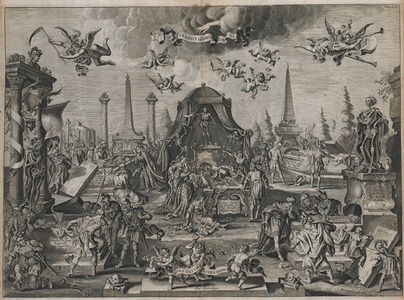| Method | Copper engraving |
| Artist | Cornelis van Dalen after Adriaen van de Venne |
| Published | Met Prevelege. [Amsterdam, c.1657] |
| Dimensions | Image 320 x 438 mm, Plate 325 x 440 mm, Sheet 382 x 450 mm |
| Notes |
Van Dalen's impressive and richly detailed memento mori tailpiece, engraved after a design by van de Venne for editions of the complete works of the Dutch poet and humorist Jacob Cats. The scene is a grand expression of the futility of earthly vanitas, and the reward that awaits all mortals no matter their deeds or achievements in life. The setting is a sprawling baroque cemetery, where the monuments of various historical figures are gathered together for mankind's inspection. Prominent amongst the funerary columns, pillars, obelisks, baldachins, and sepulchres are five large stone sarcophagi, each one engraved with the name and significance of its occupant. The tombs have been opened by crowds of spectators, who weep or cower in fear at the sight of the bones within, each group representing the current inheritors of each skeleton's estate. At centre is Helen of Troy, the world's most beautiful woman, surrounded by a troupe of great beauties. An elaborately dressed fop takes the opportunity to lift her skirts and peer beneath at her bare bones, while a beauty behind him swings a thurible of incense in tribute to the skeletal statue of Helen that stands above the tomb. To the left of Helen, Solomon's bones are exposed for the view of a crowd drawn from all nations, male and female, with academics, philosophers, judges, and rulers paying tribute to the world's wisest man. On the other side of the scene, a group of soldiers stand solemnly around the body of Samson, the world's strongest. The foreground is dominated by two kings of classical antiquity, Alexander the Great, the world's greatest warrior, and Croesus of Lydia, the world's richest man. The scene is completed by teams of cherubs carrying moral messages across the top and bottom of the scene. The hand of fate appears from a cloud at centre top, holding a ribbon emblazoned with Sic transit gloria mundi - 'Thus passes the glory of the world.' A trio of cherubs at centre bottom likewise tug at another banner reading 'Mors ultima linea rerum - 'Death is the final measure of all things.' In the top corners of the scene, personifications of Time and Fame are shown fleeing, a reminder that even these, though able to provide a simulacrum of life beyond the normal mortal reach, must inevitably give way to Death, the ultimate master of all things. The current example is usually referred to as the second state of van Dalen's engraving, though it is almost certainly a completely new plate, as the composition, while retaining the same principal elements as the original engraved in 1655, is fundamentally reworked in almost all respects. The crowds of onlookers in the current scene are much more numerous, and the burial monuments themselves considerably more dark, with capering skeletons replacing the more austere classically styled figural sculptures of the original. Whilst the banners are present in the first state, they are untitled, so it is possible that the plate was published in an incomplete state for the original issue. The first state also provides engraved attributions to van Dalen and van de Venne on the tombs to the left and right of the scene that are lacking in this state, so it is not unreasonable to suggest that the publisher Jan Schipper had the plate reengraved by another anonymous hand after the first printing of 1655, for his second edition of Cats' moral emblems, published in 1657 and again in 1712. Cornelis van Dalen the Elder (1602-1665) was a Dutch engraver and portrait painter active in Amsterdam and London. A student of Cornelis Visccher, van Dalen is best known for engraving artist's portraits as well as numerous emblemata for editions of popular and moral sayings in Dutch and English. His son, Cornelis van Dalen the Younger (1638-1664) was also an engraver, though died young. Adriaen Pietersz van de Venne (1589-1662) was a Dutch painter, poet, and book illustrator. An admirer of Pieter and Jan Brueghel, van de Venne produced numerous satirical engravings and genre scenes, often of allegorical and moral engravings of popular Dutch proverbs. Amongst these, his illustrations of emblems for editions of Jacob Cats' poems and witticisms are particularly well known. Jan Jacobz. Schipper (1616-1669), born Jan Dommekracht, was an Amsterdam-based printer, bookseller, and poet. Many of his publications feature a frontis illustration of a ship, in reference to his adoption of the pseudonym 'Schipper' in reference to his father's maritime career. Condition: Central vertical fold, as issued. Minor repaired tears to central fold. Some chipping and time toning to edges of sheet, into plate but not affecting image. Minor foxing and time toning to sheet. |
| Framing | mounted |
| Price | £1,500.00 |
| Stock ID | 52966 |

